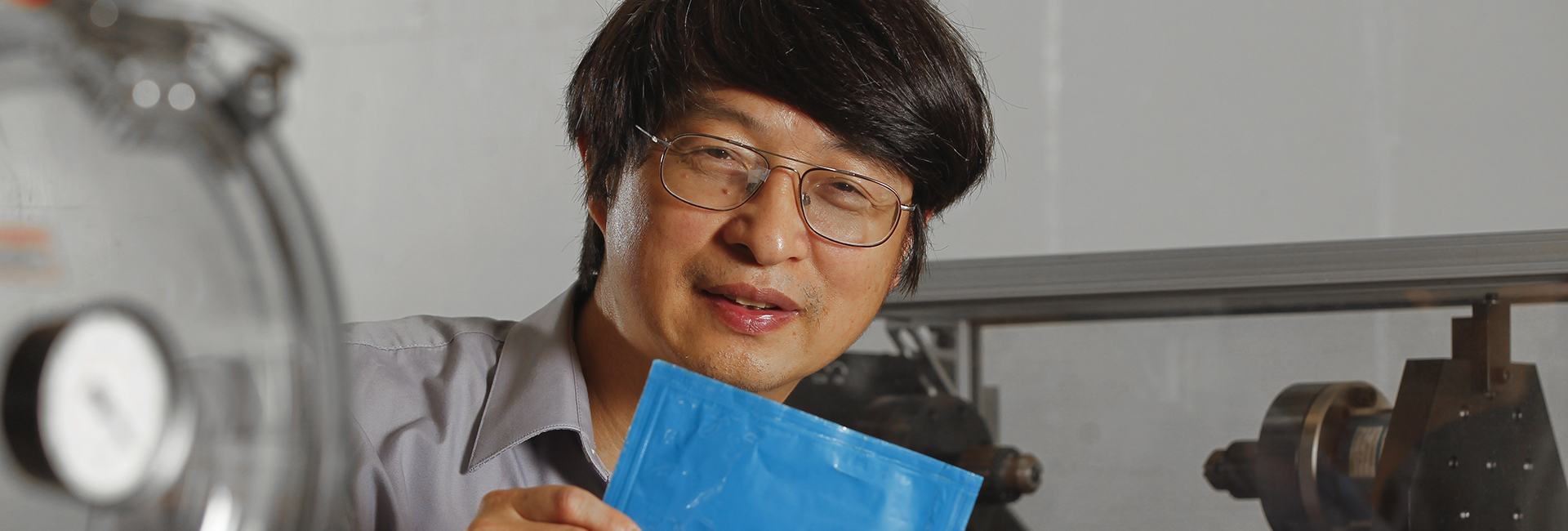

A College of Engineering associate professor is developing a prototype supercapacitor, a potential lightweight option to lithium-ion batteries.
From mobile phones to electric cars, the rechargeable lithium-ion battery is the workhorse of the portable power world. It stores lots of energy but is bulky and slow to charge.
But imagine if you could charge a machine in seconds instead of hours—with a lightweight, flexible device that can be used for multiple applications, even on a commercial aircraft.
Xiangyang Zhou, associate professor in the College of Engineering’s Department of Mechanical and Aerospace Engineering, is working to turn the battery workhorse into a new breed of racehorse.
Zhou’s prototype is patented as a "solid-state energy storage device." It is marketed under the name Flash Charge Batteries, but really it’s a supercapacitor. While the energy in batteries comes from liquid chemical reactions, which can leak and catch fire, his supercapacitor is a paper-thin, solid-state cell that works on the principles of static electricity.
About the Photo
Associate Professor Xiangyang Zhou is working to develop a new type of solid-state super battery.
Join the Conversation
Follow on Twitter:
UM College of Engineering
Dean Bardet, @UMCoEDean
University of Miami, @univmiami
UM News, @univmiaminews
While most supercapacitors can’t store much energy, they absorb and release dense amounts of power in quick bursts. Today they’re used in electric vehicles to soak up brake pad friction and convert it to energy that charges the batteries (called regenerative braking).
For the past five years, Zhou has been building a supercapacitor that stores energy like a battery while also charging and discharging in a flash. It stores and transfers much more electricity than other supercapacitors thanks to a configuration of electrolytes “sandwiched” around a middle membrane that moves electrons quickly, combined with materials that densely pack electrons. His paper-thin design has the potential to revolutionize transportation, including flight.
“Electric airplanes today can go only about 200 miles because of the storage [and weight] limitations of lithium-ion batteries,” Zhou says. “The idea with this supercapacitor is that you can make it into a panel that’s also the body of the plane. So the airplane itself is the battery.”
Zhou also says his supercapacitor is an ideal energy partner for renewables like wind and solar. Fluctuating winds and interruptions in sunlight from clouds and nightfall make it difficult to harness these power sources into a grid that requires stable input. Zhou’s supercapacitor, which could be embedded into a solar panel or wind turbine, can absorb whatever the environment dishes out and release a steady flow of electrons into a grid or battery.
Production costs and the hefty weight of batteries is why today’s electric cars are expensive and have a limited range. The life of a battery is also much shorter than that of a supercapacitor, which can be charged and discharged repeatedly without breaking down. A lightweight supercapacitor design like Zhou’s could help make fast, affordable, long-range electric cars a reality.
Zhou’s research has received funding from the Office of Naval Research, as well as private investors. His lab is presently building and testing prototypes for the supercapacitor, which he says is close to being ready for commercial use.
“Ten years ago I thought hydrogen was the most promising renewable technology, but storage of hydrogen is very difficult,” Zhou says. “Wind and solar can completely power the United States, and we can use the existing electricity infrastructure. The supercapacitor will have a very important role. I think it’s the key player in our whole energy future.”
- Meredith Camel / UM News